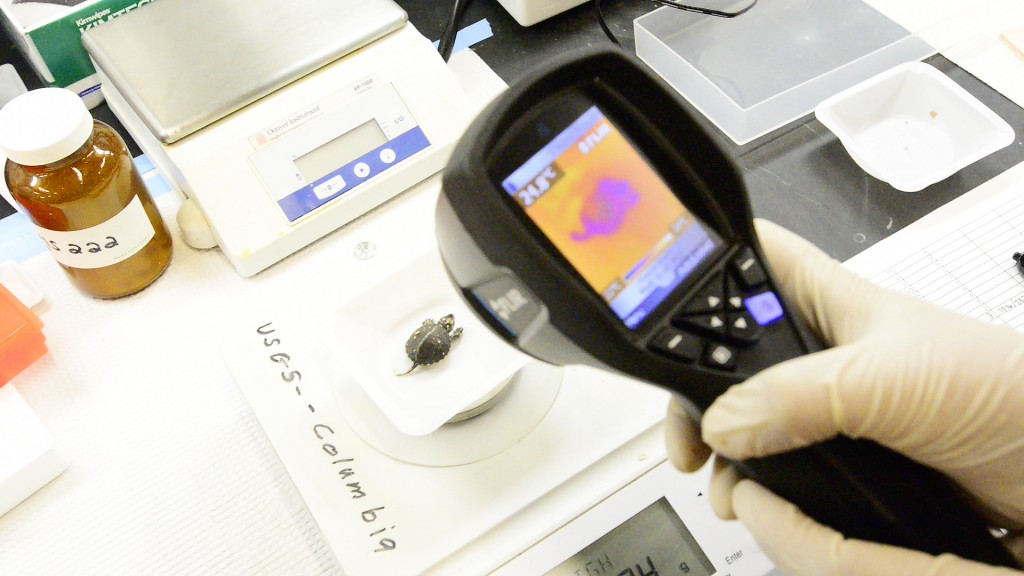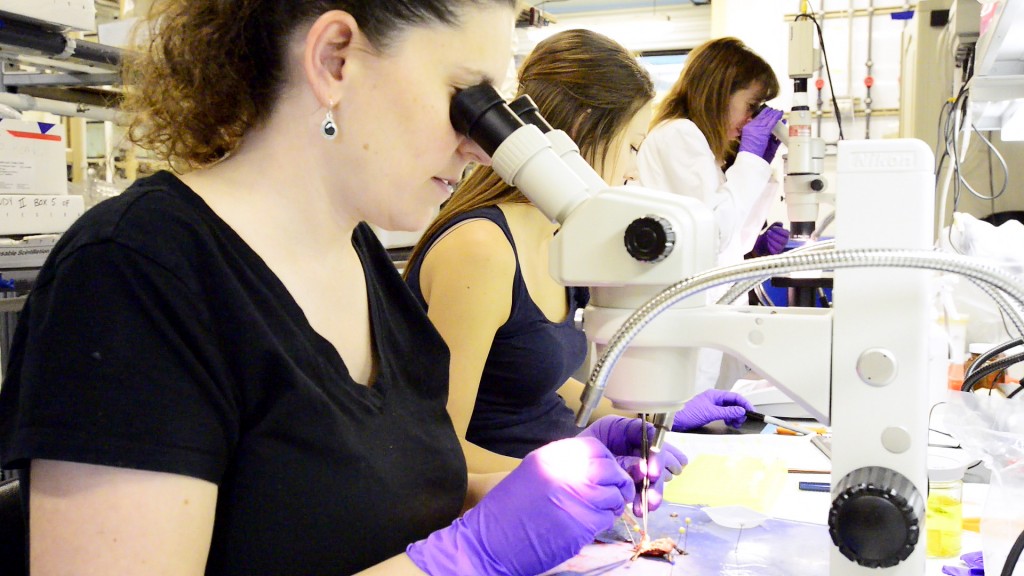
By Mariah Cox | Bond LSC
Bisphenol A, more commonly known as BPA, has been a source of scientific dispute for the past decade. With a lack of consensus among scientists, consumers are left unaware of the potential harms of the chemicals in plastic.
In response to a recent report by the Food and Drug Administration (FDA) that claims BPA is safe at the current levels occurring in foods, Bond Life Sciences Center principal investigator Cheryl Rosenfeld and a group of researchers across the country have teamed up to release a secondary analysis of the existing data, which disputes this claim.
The industrial chemical is used in manufacture of plastics and resins, and it is commonly found in plastic food containers, water bottles, food can linings and other consumer products. BPA can leach out into water supplies and food where humans and wildlife may be exposed to this ‘persistent chemical’ by ingestion or inhalation.
All of the researchers on the second report were a part of the original team put together by the FDA to study the effects of BPA. However, many researchers on that team disagree with the FDA’s re-analysis and interpretation of their individual findings.
By using the publicly available data published on the National Toxicology Program’s website, these scientists reevaluated the information originally compiled by Rosenfeld and dozens of colleagues as part of a Consortium Linking Academic and Regulatory Insights on Bisphenol A Toxicity (CLARITY-BPA).
Cheryl Rosenfeld had concerns of this Consortium project from the beginning.
“The idea at the outset was that individual investigators and FDA scientists partner together to address the question as to the safety of BPA, but even at the initial meetings, several concerns were raised,” Rosenfeld said.
The major source of disagreement boiled down to lab procedures, statistical analysis and a lack of regard for the inter-related effects of BPA on possibly multiple target organs and bodily functions. Going into it, the researchers had minimal input into the general experimental design, including a rat model that may be less sensitive to the effects of this chemical, the dosages of BPA that were tested, the fact that BPA was administered by what many consider a stressful procedure, oral gavage, and the period of administration.
One problem that was not thoroughly considered is the potential for nonmonotonic effects of BPA. That essentially means BPA shows adverse effects on the body at low and high doses, but not in between or middle-of-the-road doses.
On top of discrepancies over the research procedures, the researchers criticize the FDA for using stringent statistical analysis that may filter out important differences between groups.
“It’s like a metaphor about dropping your keys in a parking lot and looking over by the curb for them because there’s better light there,” said Gail Prins, a professor at the University of Illinois – Chicago and a collaborator on the original and secondary research project. “They’re concluding that BPA is not significant, but they’re not looking in the right places for significant results.”
In statistics, there are type one and type two errors. A type one error concludes that the results of the study were statistically significant when they’re not. Vice versa, a type two error concludes that the results are not statistically significant, but they are. Also, margin of error comes into play. P-value — a measure of deviation that determines which results are noteworthy — sets the stage for what is considered significant. Based on the method of a study, researchers can have stringent requirements for assessing the significance of a result (p≤.01), but most research uses p≤.05.
In simpler terms, p≤.05 allows researchers to be 95 percent certain that a result is meaningful. While the FDA used a p-value of <0.05, the researchers in the secondary study believe that the FDA failed to look at the statistical significance of the inter-related effects of BPA on multiple parts of the body, including the mammary glands, ovaries, kidneys, the prostate gland and cognitive-behavioral function.
Additionally, the statistical approaches the FDA sought to use would require hundreds of research replicates to be statistically valid. The FDA only had a budget to repeat the experiments up to 12 times per group, which some investigators questioned whether findings on these alone, especially with the methods the FDA sought to use, would provide meaningful results.
In 2012, the FDA banned the use of BPA in baby products, although that decision was largely due to public concern. However, the primary route of exposure to the effects of BPA are before babies are born. Since BPA is present in products used by pregnant mothers, it can lead to the development of health problems in babies including cancer later on in life.
The original statistical analysis for Rosenfeld’s portion of the project was done by Mark Ellersieck of MU, who has 30 years of experience, and a statistician with the FDA. When the analyses disagreed with each other, a neutral third-party was brought in to review the approaches used by Ellersieck and corroborated they were appropriate for the study design.
Now, Jiude Mao, a research scientist from the Division of Animal Sciences in Rosenfeld’s lab at Bond LSC, is working with Rosenfeld to reanalyze the results of the original study.
“I downloaded the raw data package online,” Mao said. “If you look at the effects of BPA on individual organs versus combining them and looking at its effects on multiple organs, the picture is very different.”
By using special informatics approaches, Mao found that the lowest dose of BPA tested simultaneously led to multiple effects on various target organs in females including the ovaries, uterus, mammary glands, heart, and fat tissue. In males, the prostate gland, along with the heart and adipose tissue showed inter-related changes due to BPA exposure.
Mao and Rosenfeld have also linked multi-organ effects of BPA at two other doses, with all doses tested currently considered safe by the FDA. They examined these inter-relationships at three age ranges: 21 days of age, 90-120 days of age, and 180 days of age. To the investigators’ knowledge this is the first type of toxicological study that has linked such data obtained in multiple investigators’ laboratories and shown such complex relationships.
The data from these three doses of BPA and three age ranges clearly indicate that BPA affects on a single organ can radiate out to affect many other organs throughout the body. By tugging on one organ, BPA can damage intricate webs that connects organs to each other. Such inter-relationships between individual CLARITY-BPA investigator data have not been considered by the FDA.
While a consensus hasn’t been met between the two parties, a potential solution for the data analysis discrepancy could be looking to machine learning or ‘deep learning’ to avoid human error or bias. This would include inputting both data sets into a program that can assess what the similarities and differences are and why the two groups are achieving different conclusions. This approach would ensure more confidence in the accuracy of the results instead of choosing a side to believe based on human calculations.
For the researchers, reevaluating the data means providing the full scope of the effects of BPA on multiple parts of the body. It also means giving consumers the correct information so that they can make well-informed decisions about their health.
“I am concerned that government agencies are not providing the public the fully story as to how BPA exposure might affect various organs, especially in infants exposed to this chemical during pre- and post-natal development when they do not have the full capacity to metabolize BPA and their organs are developing at this time,” Rosenfeld said.
Rosenfeld was joined by Jerrold Heindel, Scott Belcher, Jodi Flaws, Gail Prins, Shuk-Mei Ho, Juide Mao, Heather Patisaul, Ana Soto, Fred vom Saal and Thomas Zoeller from the Healthy Environmental and Endocrine Disruptor Strategies Commonweal, North Carolina State University, University of Illinois at Urbana-Champaign, University of Illinois at Chicago, University of Cincinnati College of Medicine, University of Missouri and University of Massachusetts at Amherst in this data reevaluation. Read more of their secondary results at the Journal of Reproductive Toxicology and see the original FDA CLARITY-BPA publication at FDA.gov.
Read more about this story at Environmental Health News. Cheryl Rosenfeld will be a featured speaker July 21 at 11 a.m. as part of a free webinar on this paper hosted by the Collaborative on Health and the Environment. Sign up at https://www.healthandenvironment.org/webinars/96533.











